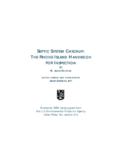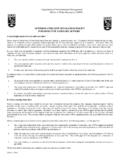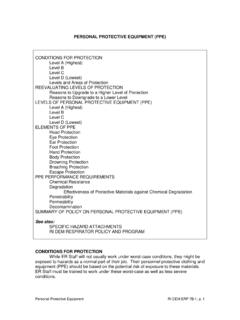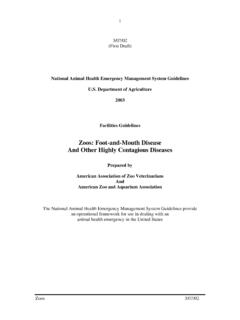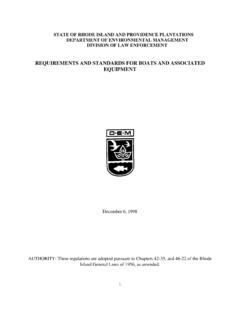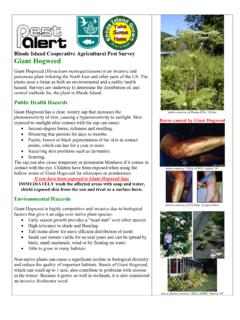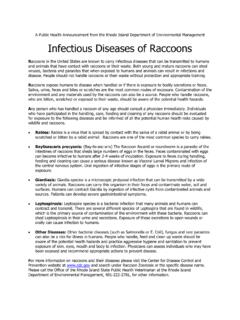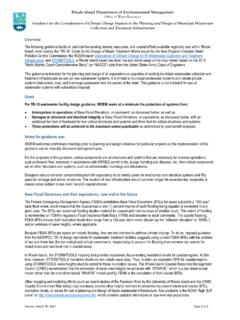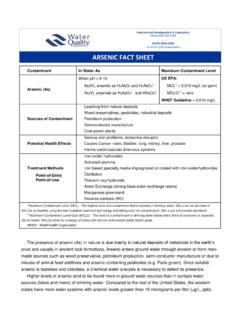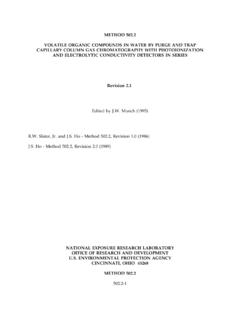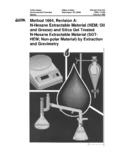Transcription of U. S. EPA ENVIRONMENTAL RESPONSE TEAM
1 U. S. EPA ENVIRONMENTAL RESPONSE team . STANDARD OPERATING PROCEDURES. SOP: 2044. PAGE: 1 of 8. REV: DATE: 10/23/01. MONITOR WELL DEVELOPMENT. CONTENTS. SCOPE AND APPLICATION*. METHOD SUMMARY*. SAMPLE PRESERVATION, CONTAINERS, HANDLING, AND STORAGE. INTERFERENCES AND POTENTIAL PROBLEMS*. EQUIPMENT/APPARATUS*. REAGENTS. PROCEDURES. Preparation Operation*. Post-Operation CALCULATIONS*. QUALITY ASSURANCE/QUALITY CONTROL*. DATA VALIDATION. HEALTH AND SAFETY. REFERENCES*. APPENDICES*. *These sections affected by Revision SUPERCEDES: SOP #2044; Revision ; 2/18/00; EPA Contract 68-C99-223. U. S. EPA ENVIRONMENTAL RESPONSE team . STANDARD OPERATING PROCEDURES. SOP: 2044.
2 PAGE: 2 of 8. REV: DATE: 10/23/01. MONITOR WELL DEVELOPMENT. SCOPE AND APPLICATION. The purpose of this standard operating procedure (SOP) is to provide an overview of monitor well development practices. The purpose of monitor well development is to ensure removal of fine grained sediments (fines) from the vicinity of the well screen. This allows the water to flow freely from the formation into the well, and also reduces the turbidity of the water during sampling. The most common well development methods are: surging, jetting, overpumping, and bailing. Surging involves raising and lowering a surge block or surge plunger inside the well. The resulting surging motion forces water into the formation and loosens sediment, pulled from the formation into the well.
3 Occasionally, sediments must be removed from the well with a sand bailer to prevent sand locking of the surge block. This method may cause the sand pack around the screen to be displaced to a degree that damages its value as a filtering medium. Channels or voids may form near the screen if the filter pack sloughs away during surging (Keel and Boating, 1987). Surging with compressed air is done by injecting a sudden charge of compressed air into the well with an air line so that water is forced through the well screen. The air is then turned off so that the water column falls back into the well and the process is repeated. Periodically, the air line is pulled up into a pipe string (educator) and water is pumped from the well using air as the lifting medium (air-lift pumping).
4 The process is repeated until the well is sediment free. Method variations include leaving the air line in the pipe string at all times or using the well casing as the educator pipe. Jetting involves lowering a small diameter pipe into the well and injecting a high velocity horizontal stream of water or air through the pipe into the screen openings. This method is especially effective at breaking down filter cakes developed during mud rotary drilling. Simultaneous air-lift pumping is usually used to remove fines. Overpumping involves pumping at a rate rapid enough to draw the water level in the well as low as possible, and then allowing the well to recharge to the original level.
5 This process is repeated until sediment-free water is produced. Bailing includes the use of a simple manually operated check-valve bailer to remove water from the well. The bailing method, like other methods, should be repeated until sediment free water is produced. Bailing may be the method of choice in a shallow well or well that recharges slowly. These are standard ( , typically applicable) operating procedures which may be varied or changed as required, dependent on site conditions, equipment limitations or limitations imposed by the procedure. In all instances, the ultimate procedures employed should be documented and associated with a final report.
6 Mention of trade names or commercial products does not constitute United States ENVIRONMENTAL Protection U. S. EPA ENVIRONMENTAL RESPONSE team . STANDARD OPERATING PROCEDURES. SOP: 2044. PAGE: 3 of 8. REV: DATE: 10/23/01. MONITOR WELL DEVELOPMENT. Agency ( EPA) endorsement or recommendation for use. METHOD SUMMARY. After installation, development of a well should occur as soon as it is practical. It should not occur any sooner than 48 hours after grouting is completed, especially if a vigorous well development method ( surging) is being used. If a less vigorous method ( bailing) is used, it may be initiated shortly after installation. The method used for development should not interfere with the setting of the well seal.
7 Several activities must take place prior to well development. First, open the monitor well, take initial measurements ( , head space air monitoring readings, water level, total depth of the well) and record results in the site logbook. Develop the well by the appropriate method to accommodate site conditions and project objectives. Continue until the development water is clear and free of sediments, or until parameters such as pH, temperature, and specific conductivity stabilize. Containerize all purge water from wells with known or suspected contamination. Record final measurements in the site logbook. Decontaminate equipment as appropriate prior to use in the next well.
8 SAMPLE PRESERVATION, CONTAINERS, HANDLING, AND STORAGE. This section is not applicable to this SOP. INTERFERENCES AND POTENTIAL PROBLEMS. The following problems may be associated with well development: 1. Overpumping is not as vigorous as surging and jetting, and is probably the most desirable method for monitor well development. The possibility of disturbing the filter pack is greatest with surging and jetting well development methods. 2. The introduction of external water or air by jetting may alter the hydro chemistry of the aquifer. 3. Surging with air may produce air locking in some formations, preventing water from flowing into the well. 4. The use of surge blocks in formations containing clay may cause plugging of the screen.
9 5. Small (2-inch nominal diameter) submersible pumps that will fit in 2-inch diameter well casing are especially susceptible to clogging if used in well development applications. 6. Chemicals/reagents used during the decontamination of drilling equipment may complicate well development. U. S. EPA ENVIRONMENTAL RESPONSE team . STANDARD OPERATING PROCEDURES. SOP: 2044. PAGE: 4 of 8. REV: DATE: 10/23/01. MONITOR WELL DEVELOPMENT. EQUIPMENT/APPARATUS. The type of equipment used for well development is dependent on the diameter of the well and the development method. For example, the diameter of most submersible pumps is too large to fit into a two-inch inner diameter ( ) well, and other development methods should be used.
10 Obtaining the highest possible yield is not usually an objective in developing monitor wells and vigorous development is not always necessary. Many monitor wells are constructed in fine-grained formations that would not normally be considered aquifers. Specifications for the drilling contract should include the necessary well development equipment (air compressors, pumps, air lines, surge blocks, generators). REAGENTS. The use of chemicals in developing wells that will be used to monitor groundwater quality should be avoided if possible; however, polyphosphates (a dispersing agent), acids, or disinfectants are often used in general well development. Polyphosphates should not be used in thinly bedded sequences of sands and clays.
